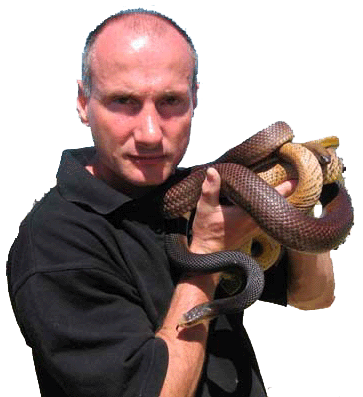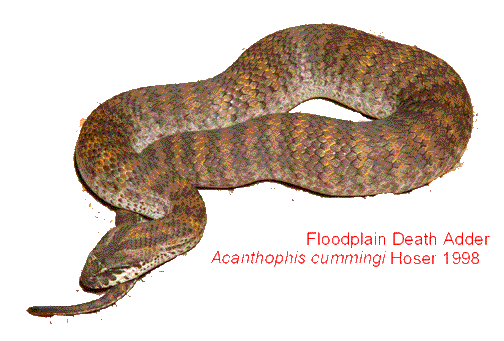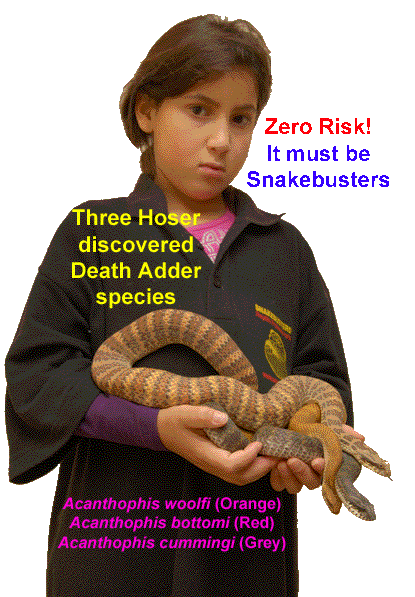The first ever reported cross-genus matings in Australian
elapid snakes (Serpentes:Elapidae).
Raymond Hoser
488
Park Road, Park Orchards, Victoria, 3134, Australia.
Phone: +61 3 9812 3322 Fax: 9812 3355 E-mail: adder@smuggled.com
Originally Published in Crocodilian 7(3)(November
2007):21-24.
ABSTRACT
This paper
documents for the first time cross-genus mating in Australian elapid
snakes. The taxa in question were a 14
month old male Northern Hill Death Adder (Acanthophis
bottomi) with parentage from Litchfield National Park, NT, and a four-year
old Copperhead (Austrelaps superbus)
with parentage from Healesville Victoria.
The mating was observed on several occasions, including 18 October 2004,
when it was photographed. The mating is
also reconciled with what is known about an apparent hierarchy between
different genera (see Hoser 2005) and also in terms of predicting other likely
cross-genus matings of Australian elapids.
INTRODUCTION
Australian
elapid species are not known to hybridise in the wild. The only possible exceptions to this are in
terms of some of the Death Adders, genus Acanthophis
(see Hoser 2002 and sources cited therein). Two more recent known hybridisations in that genus is a case of A.
hawkei and A. woolfi (both Barkly Tableland (NT/Qld) Taxa), and
another of A. cummingi and A. bottomi (both specimens in this
instance being from the Northern Territory).
In both cases young were produced in early 2007.
In the period
Jan-Oct 2004 (and beyond), I held numerous elapids of various genera for the
purposes of doing live reptile shows.
Included were
snakes of the genera Pseudechis (Red-bellied
Black, P. prophyriacus), Panacedechis (colletti), Notechis (Tiger,
N. scutatus), Pseudonaja (Brown, P.
textilis), Acanthophis (various
species, including A. antarcticus and
A. bottomi) and Austrelaps (Lowlands Copperhead,
A. superbus).
All relevant
snakes had their venom glands surgically removed using the method detailed in
Hoser 2004. All recovered from the
operation without complication and acted and behaved perfectly normal
immediately post-operation.
Other than
being rendered non-venomous, these snakes were unaffected by the operation
(including retaining their fangs in tact) and all aspects of their behavior in terms
of feeding, aggression, conduct to one another and so on remained perfectly
normal.
Contrary to
deliberately false and misleading inferences by F. Schillings in Crocodilian
and elsewhere, no snakes were “frozen” and none died painful deaths from ice crystals
forming in their blood. Snakes were
cooled to several degrees above zero and Schillings would be well aware that
the freezing point for distilled water is zero (not higher) and for most other
fluids, including biological ones the freezing point is actually marginally
below this point.
While the
initial reason for the operation was safety in terms of handler (myself) and
other persons in the vicinity of the snakes, the overriding reason for later
operations was for the snake's own welfare.
Venomoid
snakes as they have become known could be handled without risk in the same
manner as normally harmless pythons.
This removed the stress to the snakes usually encountered when handled
with hooks, tongs, "necking", tailing and the like.
As a result
the snakes remained less stressed and it became easier to observe snake to
snake reactions without the additional factor of fear of the handler.
Because
venomoid snakes had no venom, it also became possible to place different taxa
with one another without fear of one killing another due to adverse bite.
Hence it
became routine to ship and transport all the above-named genera together in a
single container and without barrier.
The limiting factor was size of snakes in that they all had to be of
similar size in a given container, so that big ones did not squash smaller
ones.
On rare
occasions that one snake bit another no adverse reaction would occur due to the
lack of venom.
The mixing of
venomous snakes of different taxa also allowed me to observe first-hand the reactions
of these snakes to one another without actually placing any individual snakes
at risk and/or minimizing it.
This point is
notable as in 2004, I had a non-venomoid Copperhead (Austrelaps superbus) bite it's similarly non-venmo0moid brother and
kill it through envenomation, which was unexpected due to the fact they were
siblings.
KEY
OBSERVATIONS INCLUDING A WELL-DEFINED HIERARCHY IN SNAKES
Snakes are
very conscious of one another and as rule prefer not to have contact with
others. This includes their own
species.
This fear is
probably based on a real instinctive fear and nervousness of being attacked
and/or eaten.
While snakes
that are grouped continually lose this fear to some extent, it remains at all
times and is readily evidenced when doing live shows with the snakes.
The snakes
don't appear to mind being picked up and moved by the handler (myself), but
when placed near other snakes or a head moves near another (as in when several
snakes are held at once) it is usual
for one or both snakes to jump away in apparent fear.
In terms of
most aspects of their lifestyles, the snakes seem to ignore one another and run
their own show. Their movements are
dictated in the main by their own preferences (for heat and food) and not those
of other snakes. When snakes tend to
group in cages, it is mainly due to a convergence of aims (seeking heat and the
like).
Notwithstanding
this, there appears to be a definite hierarchy that forms and within a species
it runs as follows, large to small and females over males, although when mating
the males literally rape the females by mounting them and attempting to
copulate.
Between
species the hierarchy in terms of Victorian taxa ran as follows: Brown then
Tiger, then Black then Copperhead. This hierarchy reflected in terms of
specimens getting right of way, best hiding spots in cages (usually one only in
my cages, even when snakes are grouped) and even positions when shipped in a
cramped container, like a small plastic tub.
In terms of
the latter this reflected in which snakes would end up on top and when eight of
the above taxa were jumbled together in a small container the positions would
reflect the above hierarchy. That is
the Brown snake/s would be on the top and Copperhead/s on the bottom.
These
positions were trend differences and not the case all the time.
Based on the
fact that in the wild state all four (above-named) taxa would rarely if ever
come across one another (although in some cases they clearly would), it is
reasonable to assume that the hierarchy that forms in the captive situation is
based on the instincts of the snakes and is literally wired into them.
As to why
different genera take a higher position over one another, this isn't known.
However the
hierarchy is important as in terms of wild snakes in some areas, it's been
assumed to date that habitat preferences is the main determinant of where
snakes are found.
The hierarchy
may in fact have a greater importance than hitherto realized especially where
the different taxa both occur in the same general area. The hierarchy may in fact be the reason why
one of two taxa is forced from one area or habitat to another adjacent one.
The hierarchy
and not habitat choice may be a major determinant in some (but not all ) cases.
In terms of
mating between snakes, snakes would not generally attempt to mate one another
when transported. The main reason for
this was the near impossibility of this most of the time.
For a given
snake to try to mount and mate another when in a tangled mass of eight or more
snakes, would be very hard.
To further
prevent unwanted mating's I tended to ship males with males and females
separately. This sex differentiation
was regardless of taxa, the result being it'd be common to ship female Blacks,
Tigers and Copperheads in one box as a tangled mass and males of the same taxa
in another box as a bundle.
Death Adders
were generally shipped on their own due to their particularly strong dislike
for other snakes and tendency to bite them, sometimes merely if crawled
over. Their venomoid state made no
difference to this behavior.
Two male
one-year-old Hill Death Adders (Acanthophis
bottomi) were frequently shipped as a pair. However it soon became apparent that one male would attempt to
mate the other male and so they were generally split up.
On different
occasions both were placed with an adult female Copperhead (Austrelaps superbus) and both mounted
and mated with her.
On 18 October
2004 this was photographed and this is the first known occasion of cross-genus
mating in Australian elapids.
For the
record, the male Northern Hill Death Adders had parents from Litchfield
National Park (NT). The female Copperhead was four years old at the time and
from Healesville, Victoria.
This was the
first time cross-genus mating has been observed in Australian elapids and based
on other observations by myself would presumably be rare indeed.
Note that the
Death Adder that mated had been heated non-stop 24 hours a day until a month
prior. It is known from over 20 years
of involvement with this genus of snakes including in terms of captive
breeding, that males heated this way do not produce viable sperm.
If held on a
12 hours heating on, 12 hours off (with the "off" dropping to below
20 degrees Celsius), then after 10-12 weeks viable sperm will be produced.
Hence it was
expected that there would be no young produced from the above union.
OTHER
CASES OF CROSS-GENUS MATING ACTIVITY
On another
occasion in September 2004 a large male Tiger Snake (Notechis scutatus) from Eltham, Victoria was placed with a large
female Death Adder (Acanthophis
antarcticus cliffrosswellingtoni) from Ardrossan South Australia. The Tiger Snake appeared to be interested in
mating the female Death Adder, but she was not interested in him. The female Death Adder spent the next 12
hours running away from the Tiger Snake in the same cage and no copulation was
possible. Days later the same Death
Adder willingly mated with another Death Adder (Acanthophis antarcticus antarcticus) from near West Head, NSW.
On another
occasion a male Red-bellied Black Snake (Pseudechis
porphyriacus) from Campbelltown, NSW was placed with a large female Tiger
Snake (Notechis scutatus) from
Sorrento or nearby in Victoria. No
mating occurred. In the first instance
the two snakes shared an upturned pot, merely to rest in, but within hours the
Red-bellied Black Snake had vacated the hide and merely moped near the water
bowl.
There was no
other hide in the cage and it was clear that the Tiger Snake had somehow pulled
rank and somehow forced the expulsion of the Black Snake, (or the Black Snake
had been intimidated enough to leave).
That the
hierarchy was in play was evidenced by this situation remaining for some
days. When the Black Snake was returned
to it's own identical cage on it's own, it immediately went to it's own
upturned pot hide (that didn't have a Tiger Snake resting in it).
When snakes
are grouped including the taxa named above (excluding Acanthophis) it is typical for the higher ranked ones to occupy the
only hide in the cage (as in the Brown Snakes), while others are forced to mope
in the open areas of the cage.
The failure of
the Tiger Snake to mate the Death Adder and of the Black to mate the Tiger, in
contrast to the success of the Death Adder to mate the Copperhead may not be
surprising if one reconciles this with the above-mentioned hierarchy.
The Death
Adder mating Copperhead was a case of a higher ranked snake mating with a lower
ranked one. In both the other cases the
snakes trying to mate were lower ranking than their females.
While it'd be
theoretically possible for lower ranked male snakes to mate with higher ranked
females, it is probably reasonable to expect such to be rarer than the reverse.
Finally, in
terms of potential offspring, no one to date has cross-bred Australian elapid
snakes of different genera. However it
is clearly possible to cross-breed different species within a genus.
In early 2004,
I obtained (still-born) young from a mating of a male Acanthophis antarcticus from Sydney, NSW, with a female A. cummingi from near Darwin, NT. That the young were still-born is believed
to have been due to the age of the female (about 12 or more years old) and more
importantly the Baytril used to treat a reovirus and it's symptoms during a
critical period in the year prior to giving birth (see Hoser 2003a, Hoser
2003b).
Baytril is
known to cause deformities in other animals, due to it's impact on cartilage
formation. The reovirus and Baytril treatment was also blamed for two other Acanthophis antarcticus females giving
birth to litters of stillborn young at the same time.
They had been
mated by males of the same species.
Acanthophis
males do not appear to have strong preferences for their own species if exposed
to other Acanthophis species, in some
cases actually preferring to mount other taxa.
The
preferences trend towards larger females, hence meaning it is more likely for a
male A. pyrrhus to mate with a female
A. antarcticus, than the other way
around.
There are
reports that Rob Bredl in Queensland cross-bred a captive Collett's Snake (Panacedechius colletti) with a
Blue-bellied Black Snake (Panacedechis
guttatus) with live young hatching.
These species are similar and at one time the former was regarded as a
subspecies of the latter. Tests on the
mitochondrial DNA (cytochome B) of the two taxa, indicate a recent separation
of the taxa (3% separation).
More recently
another cross between the two taxa (Blue-bellied Black Snake) and Collett’s
occurred, with four fertile eggs out of a larger clutch actually hatching. Two of the four young lived for about a year
until they were killed in an accident, while it is understood that the other
two lived for to maturity.
REFERENCES
CITED
Hoser, R. T.
2002. Death Adders (Genus Acanthophis):
An updated overview, including descriptions of 3 new island species and 2 new
Australian subspecies. Crocodilian -
Journal of the Victorian Association of Amateur Herpetologists
4(1):5-11,16-22,24-30, front and back covers.
Hoser, R. T.
2003a An epidemic of OPMV. Macarthur
Herpetological Society Newsletter. July 2003.
Hoser R. TR.
2003b. Reovirus - Successful treatment of small elapids. Crocodilian 4(3):23-27.
Hoser, R. T.
2004. Surgical Removal of Venom Glands in Australian Elapid
Snakes ... The creation of venomoids. Herptile
29(1) March: 36-52.
Hoser, R. T. 2005. Pecking orders in large venomous snakes from
South-east Australia ... ecological and distributional implications. Boydii (Spring 2005):33-38.
Non-urgent email inquiries via the Snakebusters bookings page at:
http://www.snakebusters.com.au/sbsboo1.htm
Urgent inquiries phone:
Melbourne, Victoria, Australia:
(03) 9812 3322 or 0412 777 211
© Australia's Snake Man Raymond Hoser.
Snake Man®, Snakebusters®, and trading phrases including: Australia's BEST reptiles®, Hands on reptiles®, Hold the Animals®, and variants are registered trademarks owned by Snake Man Raymond Hoser, for which unauthorised use is not allowed. Snakebusters is independently rated Australia's BEST in the following areas of their reptile education business.
